#Kingdom of Wallachia
Text
#nations of the world tournament#polls#poll#Hajduk Republic of Mijat Tomic#French Southern and Antarctic Lands#kingdom of wallachia#Gabon
1 note
·
View note
Text

Basarab I of Wallachia (c. 1270-1351/52).
#balkan#wallachia#principality of wallachia#basarab i#basarab the founder#Basarab Întemeietorul#voivode of wallachia#house of basarab#hospodar of wallachia#royalty#kingdom of romania#Regatul României
9 notes
·
View notes
Photo

Vladimir Ghika (1873-1954) was a Romanian diplomat and essayist who was a member of the princely Ghica family, which ruled Moldavia and Wallachia at various times from the 17th to the 19th century.
He died in prison in May 1954 after his arrest by the Communist regime.
#balkans#kingdom of romania#house of ghica#principality of wallachia#wallachia#principality of moldavia
6 notes
·
View notes
Text
IWTV S2 Ep1 Musings - Daciana: History through Visual Context in Ploiești, Romania
I immediately fell in love with The Vampire Daciana & her Romanian castle, and wanted to know more about it all.
We already know how much the set/costume designers on IWTV looooove attention to detail; they tell whole stories just through architecture, furniture, clothes, etc. So I was like OK, AMC, I see you; lemme start doing some reading up on Romania, so I can try to figure out what might be going on with Daciana. (Warning: I know eff all about Romania or Eastern Europe.)
ROMANIA
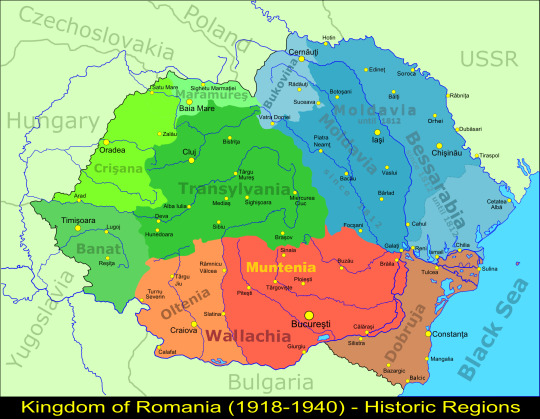
Map of Romania. Ploiești's the dot just under Muntenia, north of Bucharest, the capital. Ploiești's part of Wallachia, the IRL kingdom of Vlad Tepes (aka Dracula). Louis & Claudia went there in the 1940s, so I hope this map is accurate enough. (There's this map, but I dunno the date.)
DACIANA
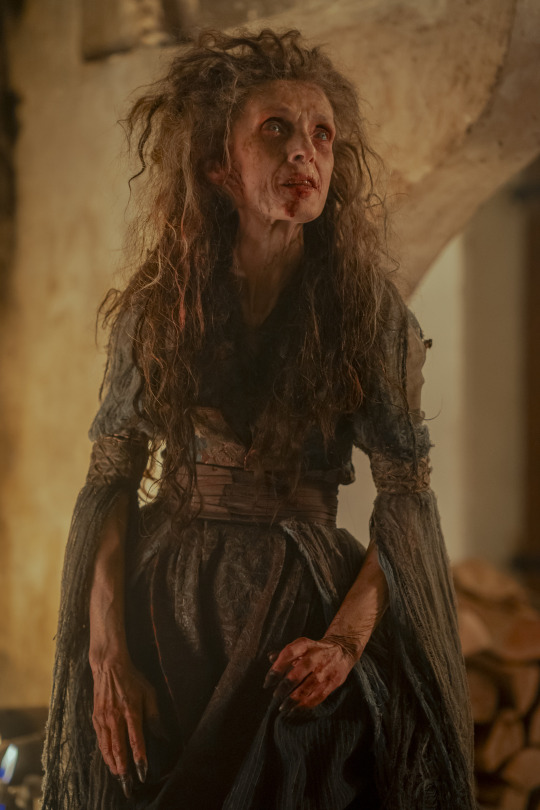
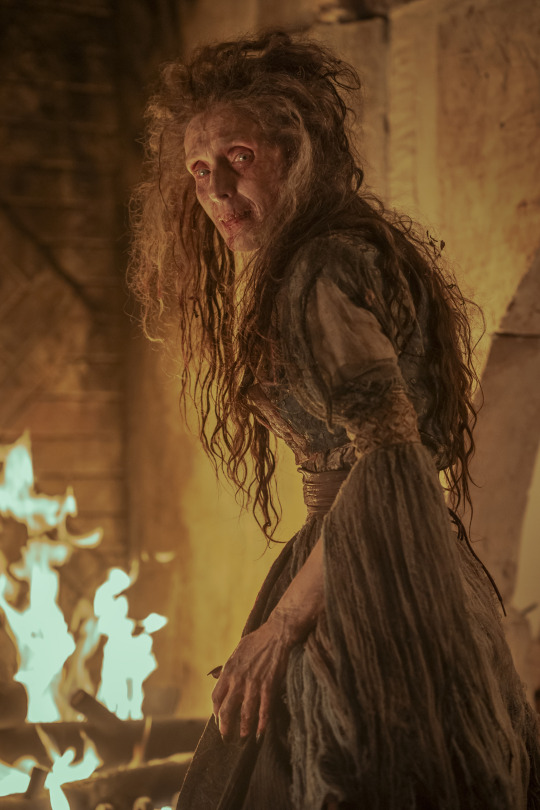
The most obvious thing about her is that she's not dressed in the typical traditional Romanian folk clothing I see all over Google, full of white-red-blue/black palettes.

Daciana's not following traditional 19th/20th-century Romanian nationalist images. Her green/brown palette & silhouette is telling, as she lacks the puffy white blouses & dark skirts. (Despite her name, I'm ruling out her being Dacian (X X)--you think you're FUNNY, AMC! But IDK about Cezare Romulo (X X); might do a Pt2!)
Sleeves
First thing's her trailing slashed open sleeves, which were screaming Medieval! at me. Here's some 15th century Renaissance examples, but with surcoats, which is different, but the sleeves reminded me of hers so IDFK.
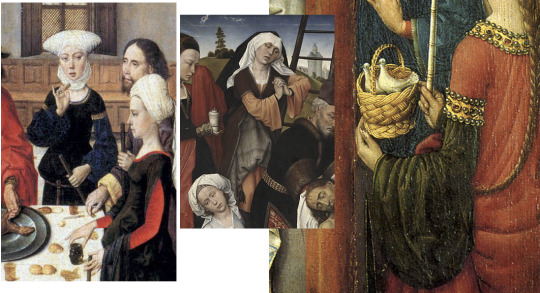
We could chalk this up to Daciana's design as just generic "medieval" fairytale stuff and keep it moving. But to give her a fair shake, I looked at local examples for anything similar that's more recent.

Traditional clothing from Huedin, Romania (north Transylvania), (X X).
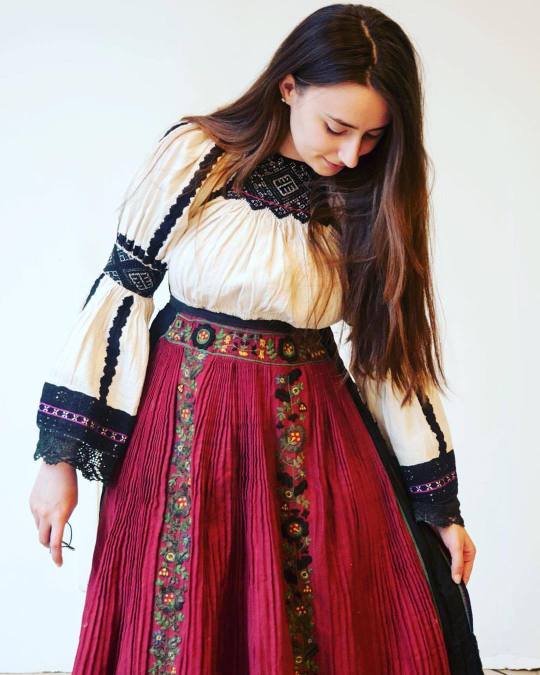
Traditional clothing from Cluj, Romania (north Transylvania).
Keep Transylvanian/Muntenian cross-cultural contacts in mind when we get to Daciana's castle, cuz it's important!

Wrt rarer non-puffy sleeves, the square cut (light blue) seems to be more prevalent in Wallachia/Moldavia/Bessarabia (southern & eastern Romania); while the rectangular cut (dark green) is all over Romania, but definitely has a concentration in Wallachia & Moldavia.
And this makes sense, cuz the style seems to also be prevalent in 19th - 20th century Bulgaria, just south of Wallachia. Hrm....

Daciana's sleeves hang very long--the only example of super long sleeves I could find is a 19th century one at the Met (C.I.47.3.4a–d). The only example of slashed sleeves I could find is in this museum exhibit at Bran Castle (yes, THE Bran Castle--I'll get to it in a minute!)
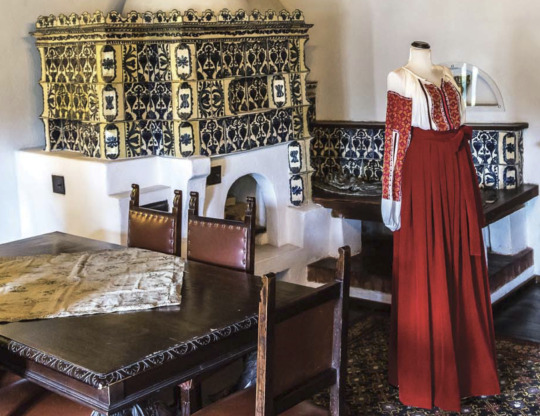
Belt, Bodice, & Fabric
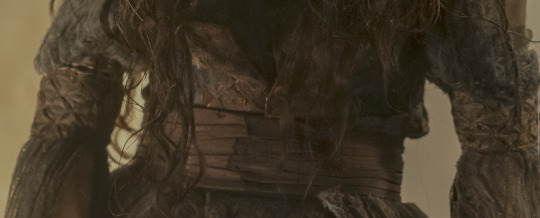
Daciana's belt is so plain compared to everything else. Is it supposed to be a leather Romanian chimir (worn by mountain/forest folk)? Those are only worn by men though? Or it depends? Or is it a just a plain cloth belt? It's reminding me of these examples (X X):

I wish I could see more of Daciana's bodice, if there's any particular kind of cut or patterns. Is the diamond netted/knotted/roped pattern on her arms significant? Her fabric is interesting, too:

What's this embroidery? Brocade? (Byzantine-Renaissance?) Damask? (c. 14th-16th century?) Lace? Something else? My brain wants to assume it's imported? Meaning: she's hella rich. Cuz like, the traditional Romanian blouse & skirt used to belong solely to peasants, b4 19th-20th century aristocrats started wearing it, too.
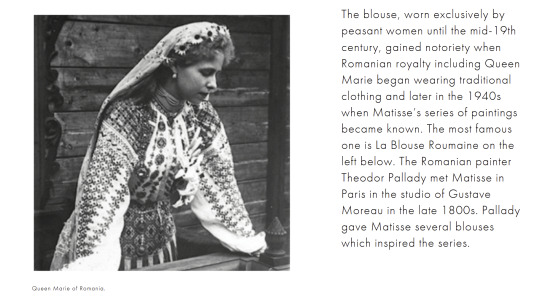
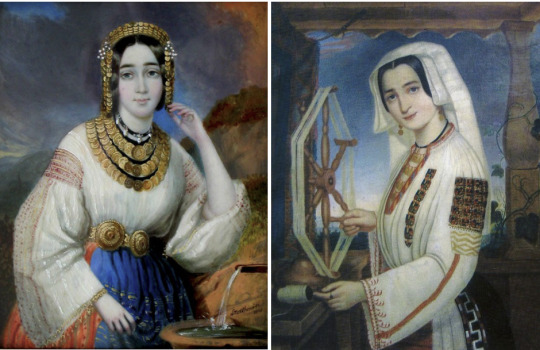
IDKY--more reading led me to a whole bunch of complicated stuff, that can probably be simplified by just saying: The Ottomans. XD

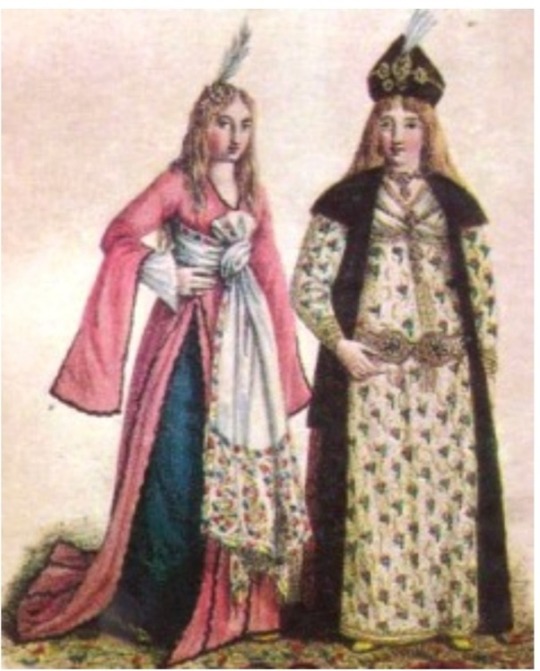
The pre-19th century Romanian aristocracy wore super opulent clothes, inspired by not just the Ottomans (X), but also the Byzantine Greeks (via 18th century Romanian Phanariote boyars (X X X)), etc. But aside from the hanging sleeves, Daciana's dress doesn't really resemble any of these foreign examples. However, it does track with my theory that Daciana predates the 19th-century Romanian nationalist/traditional clothes that became so iconic later on.
Like Louis & Claudia did, let's follow Daciana to her castle! ^0^
DACIANA'S CASTLE

I NEED to know if AMC filmed on location in Romania, or if Daciana's castle is just a studio set/green screen.
The interior's nowhere near what I expected, considering Daciana's haggard appearance. It's really nice--clean & tidy. No spiderwebs, no chipped plaster/paint, not even any bloodstains--but I've mentioned before that I think it's indicating that Daciana's a mother who takes better care of her home (and "child") than herself.
Archway
The first thing is the arch when they first come in (noticeable mostly cuz of how Louis had to bend down to get in, he's so tall).
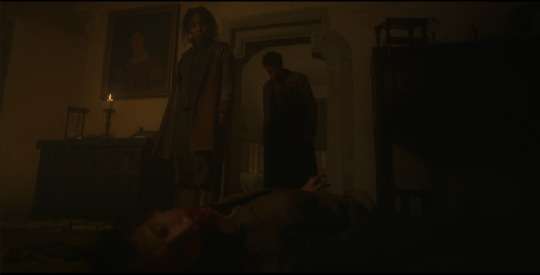
These types of doors/arches are called "shouldered arches," dating from the Medieval-Gothic periods, which Europeans adapted from Islamic architecture during the medieval Crusades. (Examples inc. Lainici Monastery in Wallachia, and the Academy of Art in Cluj-Napoca (north Transylvania).)
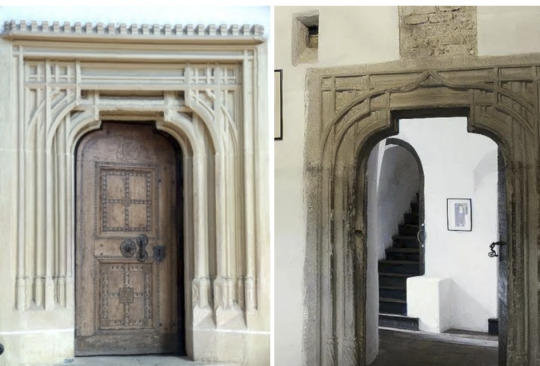
The left pic's Biertan Fortified Church, in Sibiu (south Transylvania). (Another door.) The right pic's Bran Castle, in Brasov (south Transylvania). (Another door.) (Vlad Tepes/Dracula historically never owned this castle, but pop culture says otherwise.) Both places were built by the German/Saxon Transylvanians in the 14th-16th centuries; which might help date Daciana's castle, if not Daciana herself? (The Saxon Transylvanians were in Wallachia, too.)
Wall Ornamentation
The last thing I'll discuss is the wall ornamentation/decoration:
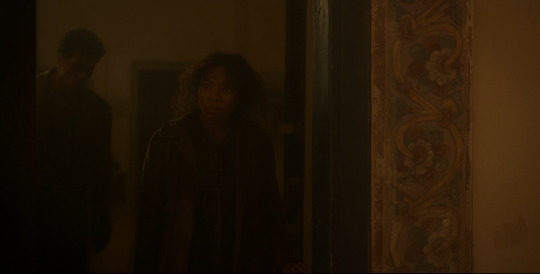
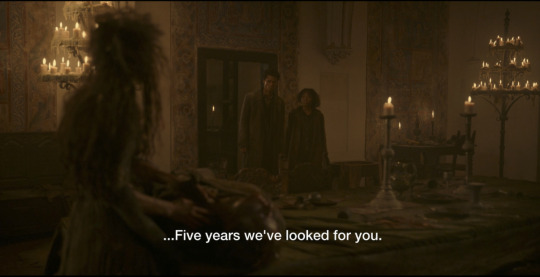
The painted floral trim everywhere instantly reminded me of The Witcher 3, as found in Hungarian, Polish, Ukranian etc buildings. Apparently the designs are all related to fertility, growth/luck, and the Tree of Life. Walls (X X X) and doors (X X) were painted. You can see northern Romanian painted ornamentation in Suceava (Bukovina).

There's painted wall designs in southern Romania, too.
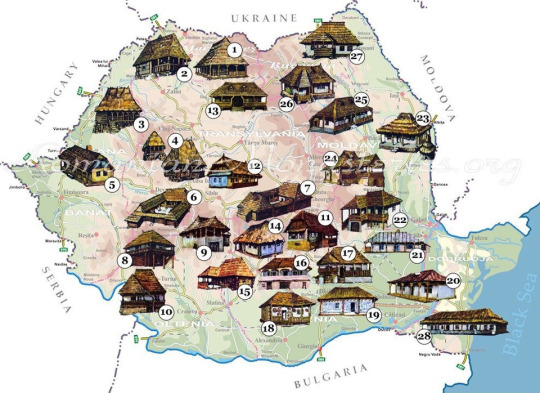
"The research of the popular interior in the Argeş and Muscel areas leads to the determination, along with a local specificity, and some Transylvanian influences, in the contact areas between southern Transylvania and northern Muntenia. In the researched areas, two lines of development of the popular interior can be observed, one relatively simple and the other complex. If the first is the prerogative of a typical Subcarpathian interior, the second represents a distinctly Transylvanian form, which was also imposed due to the presence of the Transylvanian population in the south of the Carpathians, settled in numerous villages." -- (Google Translated from Arta populară din zonele Argeș și Muscel, 1967)
(The website RomaniaDacia has A LOT to say about Transylvania, and the impact of the Germans, Saxons, Hungarians, etc on Wallachia & the rest of Romania.)

Sure enough, I was finding way more carved ornamentation (X X X X X X) than painted ones.
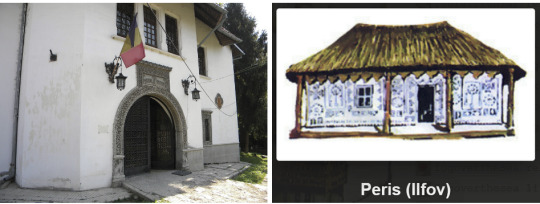
But I wonder if that's why a lot of southern traditional Romanian interiors I've been finding have totally plain whitewashed walls, too, with no painted ornaments, just tapestries (X X). I did find Romanian interior floral wall painted trims (X), but not nearly as much.
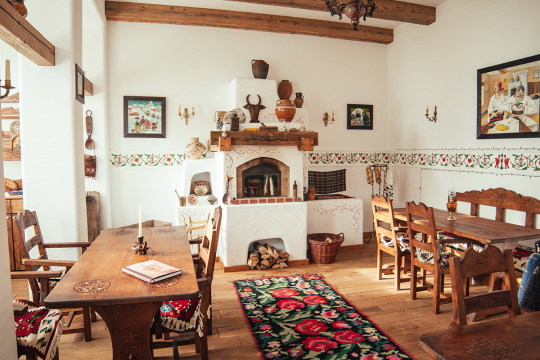
Cuz actually, the closest comparanda I was finding for Daciana was Northern European rosemaling (X X), which is also giving me medieval vibes (X); specifically: trims on illuminated manuscripts like the Book of Hours (X X X)--which we know from Lestat in S01E06.
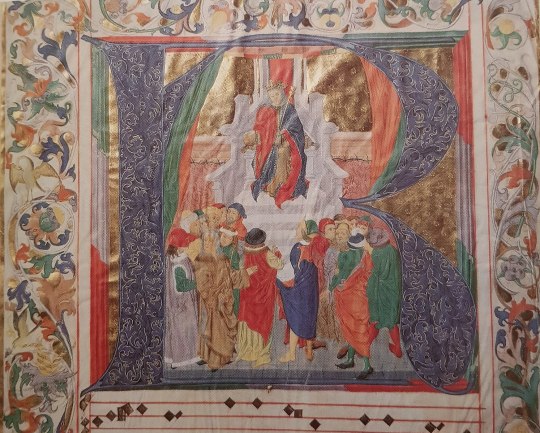
And we do see some Romanian medieval fresco borders & frescoes that had been plastered over & whitewashed, in Biertan's 15th century churches, and in 13th-15th century Darjiu (Transylvania).
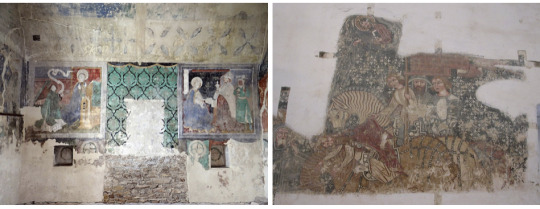
So, I wouldn't be surprised if a lot of Romanian buildings (especially castles with whitewashed plastered walls) were formerly painted similar to Daciana's. Unfortunately, I just can't find an example or figure out what AMC might've been inspired by--Romania has hundreds of castles & churches.
So, I'm tapping out--this is the most I could find so far. U_U
Results? Inconclusive! 😭 My Google-fu has failed me, LOL!
I still have no idea what time period Daciana could be from. We could go several routes:
Go by her name, and say she's ooooold AF, an actual Dacian. She's just been collating Eastern European culture as she ages, but stopped at some point (as her mind deteriorated)
She's medieval, somewhere roundabouts the 14th-16th century (making her ~500 years old, the same age as Armand--but she's weaker (as I've theorized b4), which is why she was able to burn herself up.)
Settle on her being a local Wallachian from Southern Romania, likely pre-19th century / pre-industrial early-modern Europe
Handwave everything aside as Renn-Faire fairytale fantasy; let the tale seduce you~!
OR, we can just bully AMC until they give us an extended BTS look at how Daciana was conceptualized, telling us all the tea about her! 😈
#interview with the vampire#iwtv tvc metas#fashion history#architecture#medieval europe#read a dang history book#the vampire daciana
83 notes
·
View notes
Text
Trying to figure out the year in Bram's/Fyodor's Backstory
So what I'm looking at is Vlad the impaler's timeline along with a few hints in the manga. But not much Dracula because I haven’t read the book, and also because the book takes place about 400 years later.
So the castle that Bram lived in, for people who don't know, is an actual castle in Transylvania Romania named Bran.
Basic info
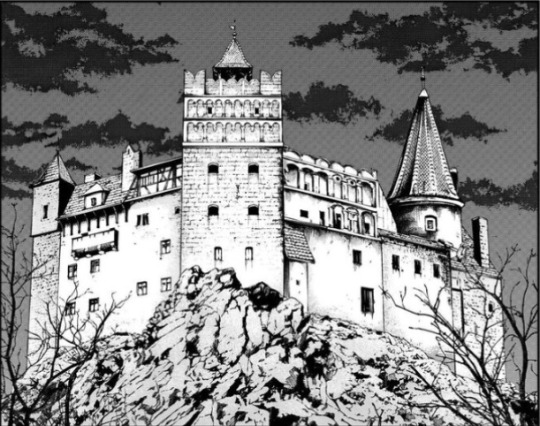
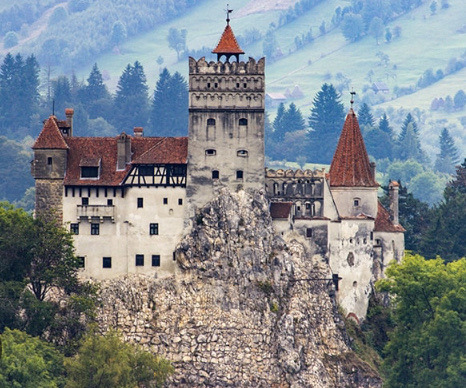
-Bran castle was built between 1377 and 1388. (Vlad the impaler never set foot in it but Dracula lived there.)
-Vlad III ruled Wallachia
-Vlad the impaler / Vlad III lived from 1431-1476 (He was defeated by the ottomans not Romans and his head was shipped to Constantinople/Istanbul)
-Vlad III’s reigns; 1448 (For a few months), 1456-62, and 1476-77.
It is a bit hard to truly connect to two while they ruled two different regions (Transylvania & Wallachia)
The knights

In this panel, we can get a look of the types of armor these knights wore.
The majority of the helmets resemble a barbute helmet which was used in the 15th century
The rectangular shields (scutum) mostly disappeared by the end of the 3rd century
Mainly spears and Halberds (The spear ax things) with an occasional sword in the crowd of knights. (Spears were cheaper at the time)
The full body armor became popular between 1400-1500s.
Byzantine empire fell in 1453 while the holy roman empire fell in the 1800s.
What nation are the knights from?
This is the main question. Are these knights from the Holy Roman empire? The Byzantine empire before it fell? Most likely not the ottoman empire due to the amount of christian symbolism. It can’t be the Byzantine empire because they rarely if at all used Halberts. Also the Byzantine empire fell pretty early so it's unlikely they were associated with Bram’s defeat. It seems like the Holy Roman empire however they did not use rectangular shields, favoring a kite or heater shield instead. Then who else?
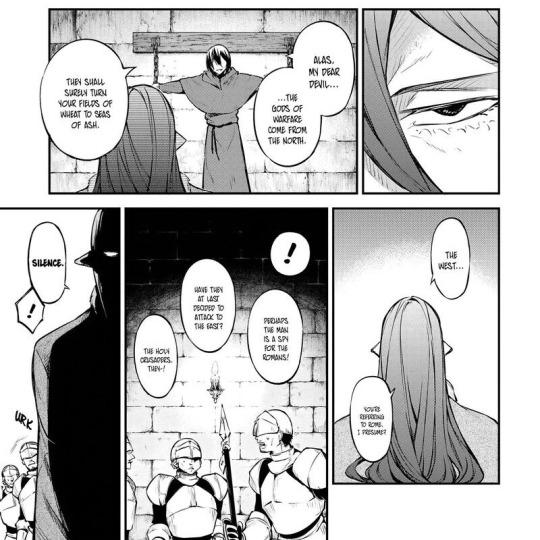

I couldn't find any good maps
Fyodor mentioned the North (Idk why Bram started blabbering about the west). Do you know what was north of Transylvania? The Kingdom of Hungary who also had a skilled army known as the black army that used rectangular shields and was big on spears and Halberd.
The Hungarian Black army (1458-1494)
From the evidence gathered so far, it must be 1458-76.
King Matthias & the Sultan

Here, Bram asks Fyodor who he serves, either King Matthias (The king of Hungary) or the Sultan (Leader of the Ottomans). Bram was suspicious of the Sultan for the reason that they started eyeing Europe once the Byzantine Empire fell, along with his history with them (Held hostage as a boy). The tension between King Matthias and Vlad III started when Matthias received a letter from the saxons allegedly written by Vlad III in which he offered support to the Ottomans. This was enough to convince Matthias of Vlad III’s treachery so he imprisoned him from 1463 to 1475. Vlad III was intercepted and captured by Matthias after he had escaped Ottoman capture and sought Matthias for assistance. This could be when Bram was defeated in the manga(?) So I guess the year may have been 1462-1463?
Some bonus info that I noticed is that Matthias signed a peace treaty with the Holy Roman empire in 1463. Maybe Bram was defeated after they signed the treaty so they could form some sort of coalition against him (This could explain why the knights all had religious imagery on their helmets).
Another thing is that Bram was impaled(?) alongside two other women. In the Dracula book, I believe it was mentioned there were three female vampires that the protagonist had to defeat before killing Dracula in the castle. This could hint towards the fact that Bram was in the castle when he was attacked and defeated.
(I'm having trouble mixing history and fiction. Fyodor definitely had a hand in this. No way he just came to warn Bram for no reason)
None of these images are mine (I'm sure you know, but just in case)
Yeah that’s all I got, please comment to correct me and/or let me know if you know anything. (Might edit later idk)
#bsd fyodor#bungou stray dogs#bsd bram#bram bsd#chapter 113#bsd#bungo stray dogs#bungo stray dogs bram#bsd theories#I just wanted to know roughly how old Fyodor is
26 notes
·
View notes
Text
Rewriting Castlevania
To be more specific, Castlevania post-Season 2. The first few seasons shall serve as the launchpads from which to build upon and iron out the kinks for later stories.
I don’t have an exact vision of how rewritten versions of Season 3 and 4 (or Nocturne, but that isn’t the focus here), but I know, for starters, they could’ve used a more compact cast.
First: remove Trevor and Sypha. They may have been major protagonists in Seasons 1 and 2, but their story was over. Alucard, as well. His story was also done… for now (because he’s too iconic in the franchise as a whole not to bring back in a sequel series).
Next: they could’ve easily cut out Morana and Striga (whose names escaped my memory until I just looked them up) without substantially affecting anything in Carmilla’s whole story. Lenore can stay (maybe as the show’s equivalent to Laura), but she should not get a “redemption”. Instead, develop the idea of how weak others see her and how her devious intellect helps her overcome her perceived weakness. Write the woman a Starscream arc, even (“I am Lenore of Styria, and fuq you, Carmilla! I win!”), with mistress Carmilla as her Megatron! Give her lots of ambition!
For Isaac, I would love for his chat with that Captain to be preserved (I rewatched it recently and loved the vibe of it), but a couple other events in his journey need adjustments so that he doesn’t go through the “I had an nice talk with a human, so my mind about humanity is changing, but these guys are blocking me and I can’t reason with them, therefore I’m stupid for trying to be civil and hate humans again, now they die!” bit twice. With a little streamlining, his screentime in Season 3 could be devoted to building him up as a threat, and then set up Season 4 with his role as a co-antagonist (with Carmilla) to Hector fully set up when they reunite. No sanitizing “I’m going to live!” revelations here.
Then there’s Hector. I still think we didn’t need to see the immediate aftermath of his imprisonment. In this hypothetical rewritten story, I would suggest having a 1 or 2 year timeskip, so he’s been slaving away in Carmilla’s dungeon for quite a while, forced to build her an army with his Devil Forgemaster powers, and Lenore’s been keeping watch and giving him plenty of incentives not to betray the sisters. Maybe for his first appearance in this version of Season 3, he could have this intimidating reveal where it dramatically shows the scrawny boy from Season 2 has become a buff, scarred son of a gun, clearly having worked out a lot during his year(s)-long stay.
The story following the Castlevania 3 adaptation would not have to be a Curse of Darkness adaptation, but the pieces were in place to pass the main protagonist torch over to Hector anyway. By making Season 3 all about his eventual escape, and having Season 4 follow him on the run, eventually overcoming his oppressor (Carmilla) and former partner (Isaac), we have ourselves a cohesive story that blends everything it establishes into one, airtight package, rather than feeling like a convoluted animation anthology.
Also, maybe Saint Germain’s Infinite Corridor quest can be worked into Hector’s adventure to freedom in some kind of creative way, without Saint Germain having to sacrifice his morals or gain info from a shady 3rd (or 4th) party.
Reply: I like your ideas!
Hard agree on removing Trevor and Sypha because they are effectively done, and Morana and Striga because they add absolutely nothing of importance. Ellis said that he created the council to explain who ran the kingdom while Carmilla was in Wallachia, but Lenore could do the job herself. I’m not sure about Alucard because his story is also over, but I do see the potential of him grappling with his grief, and fearing he might become like Dracula. It’s just, the way it was done was skull-crushingly boring, and for now I have no better ideas.
(btw yes, Carmilla and Lenore could be wives at this point lmao, their personalities are strong enough that it wouldn’t come off as The Lesbians For Brownie Points. Maybe Carmilla turned Lenore so she’s her dame and superior, and this would cause frustration in Lenore who feels like Carmilla sees her more as her pet than a lover... frustration that she channels on Hector, in some sort of cycle of abuse way :) I still like the idea of her falling in love with Hector, but it’s an unhealthy, possessive love typical of a vampire, that Hector doesn’t reciprocate or grows out of.)
For Isaac, I mentioned the other day that he could use as a springboard the realization that Dracula cast him away like a broken tool, and from there, his affirmation that he’s worth more than what Dracula told him. ... yes, this is still Hector’s arc, but whatever at this point. Absolutely, S3 should avoid that stupid pattern of “oh maybe humans aren’t so bad-- nvm y’all rude, die”. Maybe he avoids people instead of barging through cities, and makes his army from the corpses he finds in abandoned towns? But he still can’t avoid everyone, hence, the scene with the captain.
Mhh. Hector’s story spanning so long would also influence Isaac’s, and it feels like too much? If Isaac had one year of time to build an army, dude would lead a small country basically. He’s already OP af, even if we nerf him by making him weak in physical combat. Same with Carmilla, she would definitely do some damage in one year.
I’m torn. Hector’s story in S3 could be tweaked a bit by making it less fetishistic and still treating Hector like a person: as in, someone with goals and principles and was not hired as General only because he’s pretty, that Lenore has to whittle down to convince him to work for him (the idea that Hector cannot be physically forced to work and his master needs to earn his trust is actually really good for a conflict). The two should butt heads and have more intriguing conversations, make the job harder for Lenore, let’s see if she keeps with the diplomacy or gets frustrated and needs to resort to the ring (which only makes sense in the scenario where Hector is deemed too dangerous to be allowed to work freely, since its only shown function is to bequeath control of the Creatures). I actually jotted some ideas down, if you’re interested :P
(oh, and no rape. obviously. she really didn’t need to do that.)
And S4 can kind of stay the same, but with the difference that Hector trapping Lenore is a form of cruel mercy, he does not crawl back to her because he too realized he does not need to cling to people to earn love, and he actually leaves the castle, ready to explore the world (with the implication that he might meet the equivalent of Rosaly, but it’s not necessary)
To clarify, what is your idea of Hector’s story in S4? Does he flee from Isaac on the chase? Will he eventually fight him and Carmilla? Will he meet Rosaly in the finale, and in this timeline they stay together without Isaac interfering? (please say yes 🥺)
But yeah. I still think the prequels could have been adapted, but if we need Carmilla as a spanner in the works tweaking the timeline, this feels much better. Trevor and Sypha alone not bogging down screentime would solve so many issues with the rushed pace.
13 notes
·
View notes
Text
Did Saito abuse Ferid?
An 'analysis' of their past together
The thing which made me wonder about the first question was this panel:

First of all, manipulation is also an abuse tactic, therefore Rigr surely abused Ferid in this manner. Though, I'm keen on looking at deeper stuff here regarding abuse.
Ferid likes to joke around and amuse himself by making people shocked from his eccentric words and behavior, but sometimes his jokes mean something deeper.
If you don't know what a Lolita complex is, here is an explanation:
Lolita complex is the sexual attraction towards young or pubescent girls. This term is based on “Lolita”, the book of Vladimir Nabokov; the story centers on a middle-aged man who became obsessed with his 12-year-old daughter.
For better reference, this is a more detailed summary of the novel:
Humbert is the narrator of the story. He explains his fascination and admiration towards “nymphets” which are (realistically speaking, leaving his delusions behind) simple young girls between the ages of 9-14 which are the only females he can be attracted to. He stays in the house of Charlotte haze and there he meets her daughter, Dolores Haze. (Lolita, as he nicknames her) He's obsessed with her enough to get married to her mother just to get access to Lolita. Eventually, Lolita's mother dies and therefore she becomes Humbert's step-daughter. Throughout the book, Dolores is exposed to manipulation, sexual abuse (which sadly, yes, it occurs with Humbert), physical abuse and verbal abuse. In the end, Dolores runs away from him later, meeting Humbert again when she's 17 and pregnant while she asks him for money. I won't give more spoilers from here, in case someone wants to read it.
I've also analyzed Dolores and Humbert and somehow, Lolita's story slightly reasonates with Ferid and Humbert is similar to Saito.
There's no actual proof that Rigr sexually abused Ferid, though there might be a chance that Rigr physically abused him. Violence, especially physical punishments for children, was very common and normal in the medieval times. I'm sure that Ferid was exposed to enough violence and torture in the times when he was a prince and that his parents gave him punishments for his eccentric behavior.
There's a chance that Rigr physically punished him,
Lolita was never shown what love properly feels like. Her father died when she was a kid, her mother loved her but didn't know how to properly show her that and then the only father figure she had showed her that she's only something to be desired, not loved or cared for.
Ferid was also never shown love. His parents who were royal were more preoccupied to fulfill royal duties and to teach Ferid on how to become a saint. His brother, instead of caring for his little brother who was having depressive thoughts, cared more about making him only a political pawn. Rigr most likely also took a 'liking' to Ferid since they met when he was a depressed sixteen/seventeen year old, thus he was easier to manipulate. When Ferid was older and more mature, Rigr discarded him like he was nothing. Same as how Humbert started to be more violent and find Lolita uglier as the time passed by and she grew older.
Ferid left his Hungarian kingdom when he was 16 and killed his brother and since Rigr was also leaving Wallachia (Romania) during that time, it's a possibility that they met while Ferid was heading towards the south. There's also a theory that Rigr may be Ferid's actual father, since Rigr implanted his dna in the Bathory family and also the Ichinose family. Ferid was always saying that Rigr is his father, yet Crowley never said that Ferid was his father nor the other progenitors said that the first was their father. Ferid wasn't even joking when he was calling Rigr his father, since even in the light novels he was calling him a dad and being serious, with no jokes going around.

Here, as you can see Ferid's vulnerability when Rigr pats his head, he immediately leaves. Perhaps Rigr did that gesture often when he was manipulating Ferid and that's why I assume that it bothered him so much. Rigr was obviously trying to upset him here, he knows best about his weaknesses
In conclusion, it's a possibility that Ferid's joke was corresponding with his situation, that's why he was mentioning it. Usually when he makes jokes they seem to be out of context and extremely odd but most of the time they aren't actually out of context.
14 notes
·
View notes
Text
CD SHORTS: What did the Ottomans want to do with the Romanian Lands in the 15th century?
Bulgaria, Byzantium, Serbia, Bosnia, and Albania all met their end, becoming mere Ottoman provinces (sanjaks). Why didn't they do the same with the Romanians?
The Ottomans' greatest fear in the 15th century was the Crusades and the tens of thousands of mobilized Christian soldiers.
The only entity that could convince the Vatican to declare a Crusade was the Kingdom of Hungary.
If the Ottomans threatened the Hungarians by annexing the Romanian Lands, the king had the option of initiating a holy war and taking advantage of those masses of European soldiers.
The Ottomans' solution was to use continuous political and military pressure to force the integration of the Romanian Lands into the pro-Ottoman bloc.
This did not directly threaten Hungary, nor did it support it in any way in its crusade initiatives.
Without the logistical support of Wallachia in particular, the Crusaders could not advance into the Ottoman Empire, as demonstrated by the Crusades led by John Hunyadi in 1443-1444.
The last ruler of medieval Wallachia who resisted the Ottomans was Vlad the Impaler.
For more information about the Romanians and the last Crusades in the Balkans, see:
youtube
#cd shorts#romania#history#vlad the impaler#ottoman empire#15thcentury#youtube#corpusdraculianum#Youtube
8 notes
·
View notes
Text
WTW Planet Prompts | Venus | Politics
The conflict with the Saxons and the war with Ottomans were at the center of Senka's rule as Wallachia's queen. While the Saxons were more of a short-term problem, the Ottomans continued to pose a threat long after her husband's alleged death, and were viewed by many as the queen's greatest and most hated enemy.
Though the politics in the region shifted as the centuries wore on, Senka did not stop her campaign against the Ottomans — though she often pursued this in a more private manner, since upsetting the peace in her country was not something she wanted to do.
When the empire fell in the early 20th century, Senka had no choice but to end her campaign against the Ottomans, and reluctantly withdrew to her castle — though she did not stay there for long. With nothing but memories to keep her in what was now the Kingdom of Romania, her brother encouraged her to return to Ireland with him, and occupy their family's home. With some reluctance, Senka agreed, though she made it clear she would not stop her career in politics — nor her search for her husband — for that was what she had spent the last several centuries doing, and it was now a part of her that she could not, and would not, abandon.
6 notes
·
View notes
Text
epic rap battles of history mehmed ii of the ottoman empire vs vlad iii of the kingdom of wallachia
3 notes
·
View notes
Text
1 note
·
View note
Text

Dracula in Hungary
Bram Stoker’s Dracula, published in 1897,pictures a cruel vampire’s story, but many people who have read the book are not aware that the character Dracula the vampire is based on was a highborn member of a Romanian court, prominent in European history — and much more terrifying than his fictional descendant.Prince Vlad, or as he was called even in his own time, Dracula (which means “Son of the Dragon”) tops the list of Romania’s many, many Christian crusaders who, in the transition years between the Middle Ages and the Renaissance.He ruled his military kingdom of Wallachia — southern Romania — with a heavy and blood-soaked fist. A pamphlet published in Nuremburg, Germany, immediately following his death in 1476, tells of his burning beggars after allowing them free food at his court. “He felt they were eating the people’s food for nothing, and could not repay it,” the broadside explains. And there are countless of other tales of Dracula’s wickedness written down ages ago. But, Vlad Dracula was more than just a medieval despot,He was a politician; a voivode (warrior); an erudite and well-learned gentleman when the occasion-to-be fit; and, as has been indicated, he was a mass murderer. He spoke several languages — Romanian, Turkish, Latin and German — and steeped himself in the use of broadsword and crossbow. He was an equestrian, riding at the head of his attacking army like a Berskerker.
The adventurous life led by Dracula put him in contact with the era’s most fascinating people, among them “White Knight” Jonas Hunyadi, Hungarian King Matthias Corvinus, who imprisoned him in the Salamon Tower of the Visegrád Castle between 1462 and 1474, but was then returned to his rank.
See less
Edit
All reactions:
7Júlia Koleszár, Luis Magaña and 5 others
7 notes
·
View notes
Text
Book Review: The Conqueror's Saga by Kiersten White (🇷🇴 Romania)


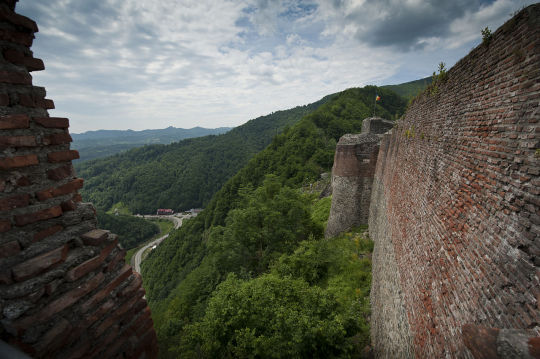
[image 1: book trilogy covers: And I Darken, Now I Rise, Bright We Burn. On each cover a spear slashes through an object: a flower, a necklace, a pomegranate; image 2: map showing modern Romania; image 3: the view from Poenari castle in Romania - the walls of a stone fortress drop away to a steep mountainous landscape covered in green; source: wikimedia]
And I Darken; Now I Rise; Bright We Burn
Author: Kiersten White
YA World Challenge for 🇷🇴 Romania
I've seen some criticism of this series by Romanian reviewers, one of which is Lada's name (which I agree is odd), and others that are to be expected when you take a national hero (Vlad the Impaler), gender-flip him, and write him in love with the leader of an empire that oppressed your nation for centuries. So it's important to acknowledge this series as pure fiction. It did have me flipping through Wikipedias of the the real historical characters mentioned, many of whom I had never learned about before.
While much of the series (1 and 2 especially) take place in the Ottoman Empire (modern Turkey), the series follows the point of view of two siblings from Wallachia, a historical region of the modern state of Romania.
Review
Lada and her brother Radu are left as hostages of the Ottoman Empire as children to keep their father "loyal" as a vassal. I loved Lada's character from the beginning: strong-willed, possessive, brutal even as a child, and "ugly". The character-building was expert and the way the author weaves relationships and motivations in a complex tapestry, against a backdrop of a rich world.
And I Darken builds the siblings' relationship with the future sultan Mehmed, setting up that messy love triangle, and a scheme to get Mehmed on the throne. While Radu falls for Islam, Lada is never not wholly dedicated to Wallachia.
With Now I Rise, oh lord, the gay angst!... dear Radu. With Lada gone off to find support for her kingdom, Radu is left with his angst. We see the battle of Constantinople, and interconnected politics around Eastern Europe as Lada raises her army and searches for allies.
Bright We Burn, and Lada is ready to go full-on Impaler. The action was great, until... the entire climax and ending. I felt the finale really cheated Lada and did not serve her character. I didn't feel that book 3 lived up to its title. (And god, what a cringe epilogue!)
I have such mixed feelings about this series because it is incredibly well-written and engaging throughout, with an epic world and depth of character. But I dislike the ending the more I think about it. Without spoilers, I can just say that I think the whole feminist theme built up through the book fell apart in the end.
Books 1-2 I would have rated 4.5 stars, but Book 3 ultimately pulled the rating down.
Other reps: #muslim #gay #m/f #lesbian side characters #orthodox christian
Genres: #alternate history #drama #romance #adventure #war
★ ★ ★ 3 stars
SPOILER rant under the cut:
In Book 2, the gunpowder lady said something to Radu - that Lada would be the type to go out with fire. With a title called Bright We Burn, I fully expected to see Lada going down as brightly and destructively as a meteorite, taking herself out with everything. What a disappointment.
The ending and Lada's forced 'submission' to Radu, by him taking away every last thing she had, under the guise of *compassion*, quite rankled me. It took away all the independence of her character that the series had built up from the beginning, and replaced it with nothing.
And. The. Kid. That epilogue. No, just no. I hate that such a promising series had to end with the cisheteronormative notion that "you must bear progeny to have a legacy". Fuck that. It completely threw away everything that Lada was just to have this "oh cute she acts like her mother" moment. 🤮 That and Radu vandalizing the church floor with his weak, misogynist scratchings.
It could have been so much better.
#book review#ya world challenge#romania#and i darken#now i rise#bright we burn#historical medieval to 19th century#historical fiction#romance#drama#adventure#war#alternate history#m/f#gay#lesbian#muslim#orthodox christian
7 notes
·
View notes
Note
Isaac, Hector, what language did you speak to each other when you first met?
Isaac: Wallachian. What else? Should have I performed in my best Neapolitan? Hahaha!
Hector: We both come from different kingdoms, but we were raised in Wallachia. Language has never been a problem for us.
#ask hector and isaac#my headcanon is that the laforeze family comes from the kingdom of naples (southern italy)#for multiple reasons#i would love to tell you how greece was called by the time hector was born but it looks like the 15th century was a turbulent time lmao
2 notes
·
View notes
Note
5, 10, 17, 31 for both Vlad and Trystan dear Lin! <33
My most beloved Mads! Thank you for sending these my way. It means the absolute world to me! 🥰️❤️️
5. What sort of succession system is it? Agnatic? Primogeniture? Gender-biased?
In Vlad's 15th-century Wallachia, the succession system is not fixed but rather functions as a loosely structured polity. Future voivodes are chosen from any male members of the royal family who are not disfigured or maimed noticeably. This type of succession is defined as os de domn (of voivode marrow), which means that any man from the royal family (brother, nephew, son, etc.), regardless of being born as a legitimate son or not, has the right to become the ruler of the land. At the same time, the voivode does not need to consider the order in which possible successors are born but instead chooses his heir based on skills and capabilities, hence why it is not uncommon for the heir to first become the associate ruler which allows the voivode to prepare his successor and teach him the craft of politics. This type of succession is, to a certain extent, favourable as it eliminates the stigma associated with illegitimate children because, regardless of whether they are born out of wedlock or not, all male members of the family are treated equally and have the same opportunities. However, it also creates an unstable political environment characterised by frequent violent power struggles among family members.
In Trystan's 21st-century Drakovia, the succession system is primogeniture, meaning that the firstborn legitimate child inherits the throne. Unlike in the past, this system is no longer biased based on gender, allowing daughters of the kings to also become rulers (this option was implemented through the Drakovian Pragmatic Sanction which allowed Queen Catalina to rule during the last two decades of the 1800s). This type of succession ensures the stability of the country, with the heir being prepared for their future role from childhood. However, it does discriminate against the illegitimate children of the king, which is why Juliana Georgescu eventually proposes the draft of the Drakovian Act for Heir Equity.
10. Is the dynasty old? Or new? How does this affect how they operate?
Vlad belongs to the House of Drăculești, which traces its origins back to Vlad’s father, Vlad II Dracul (Dragon). While the family is part of the House of Basarab, the Basarabs eventually split into two separate lines, with the other line being the House of Dănești. These two lines have been in constant competition for the throne since the late 14th century. The Basarabs are a ruling family of Cuman origin, and they established Wallachia as a state in the early 14th century under the leadership of Basarab I (hence the name of the royal house). At the time of Vlad’s first rule in 1448, the country (and the royal house) is still relatively young, being only 138 years old. The relative youth of the House of Basarab itself does not cause problems in the functioning of the state. However, the split of the royal house into two lines certainly contributes to the instability in the region.
Trystan belongs to the House of Tornović which first began to rule Drakovia in the 18th century. Prior to Drakovia becoming a Socialist republic in the 1940s, the royal family was renowned for being enlightened rulers who promoted education and art. However, due to the volatile and turbulent political landscape of the Balkans, the Tornovićs often had to govern with an iron fist, making them rather authoritarian, almost despotic. After the fall of the Communist regime, the descendants of the House of Tornović return from exile to a country that becomes instantly engulfed in a bloody civil war that ultimately leads to the restoration of the kingdom at a high cost. However, due to the volatile nature of regional politics and the transformation of Drakovian society, the country merely undergoes a different kind of dictatorship under the rule of King Maksim, Trystan’s father.
17. Does your OC dislike living in the public eye? Or do they believe it's part of the job?
Growing up in the family of the Great Pretender and later moving to the Royal Court in Târgovişte, Vlad is accustomed to being in the public eye. He sees it as a small price to pay for being a Drăculea, and it is an aspect of his life that he does not have a personal preference for but rather sees as a constant presence. He can manage it as long as he can find a way to maintain some privacy for his family and for an environment where he can simply be a regular person for a while. However, when he becomes a prisoner at the Hungarian court, he strongly dislikes being constantly observed by the public, primarily due to the constant humiliation that comes with it. He begins to prefer the solace of privacy, being surrounded only by family or using it for quiet contemplation.
Trystan not only enjoys living in the public eye, he thrives in it. Whether he is publicly praised as an enigmatic heir to the throne or closely followed as a scandalous rebel in exile, he relishes the attention at all times. His perspective on public life does not solely derive from being born into the most closely observed family in the kingdom, it also arises from his personality and his somewhat eccentric soul. However, this perspective shifts with age as he develops a greater appreciation for tranquil environments and a desire for privacy.
31. Your OC has been the target of some bad press. What do they do to straighten out the story?
It is a historical fact that Vlad's reputation has been tarnished by a series of pamphlets aimed at ruining his image, so much so that this negative perception of him persists to this day. During his imprisonment by Hungarian King Matthias Corvinus, Vlad had no opportunity to correct the narrative or defend himself against the slanderous accusations and, as a result, his bad reputation has continued to follow him without anyone giving him the chance to make his voice be heard. After his release and his third time becoming the voivode, Vlad is too disillusioned and bitter to even think about actively addressing his tarnished reputation. He only cares about being understood by his family and closest associates.
Trystan firmly believes in the motto that “any press is good press”, so he isn’t easily offended by negative publicity. He is accustomed to appearing on magazine covers due to his supposedly scandalous behaviour and enjoys being seen as a provocative rebel. However, if the bad press includes something too sensitive, he would go to great lengths to restore his reputation. For instance, there is a lingering cloud of suspicion surrounding his involvement in Juliana Georgescu’s death, and the desire to uncover the truth (and potentially clear his name) continues to haunt him for years. Eventually, we know that the Detective helps him uncover what truly happened on that fateful night.
3 notes
·
View notes
Text
256: Maria Tănase // I

I
Maria Tănase
1965, Electrecord
Maria Tănase’s Wikipedia entry repeatedly describes her as Romania’s Édith Piaf, and superficially I can see it: both are to my inexpert ear mezzo-sopranos, lived at the same time, died relatively young, and became cultural heroes in their respective nations. While Piaf remains a giant of global music and Tănase is little known outside her country, based on this 1965 compilation’s liner notes Tănase’s significance to Romanian music may surpass that of Piaf’s to France. As her biographer Harry Brauner (himself an interesting figure) tells it, Tănase was the artist most responsible for stitching Romania’s diverse folk traditions into a modern national music. Fascinated since girlhood by the folk songs taught to her by her parents and the peasant women who worked in her father’s plant nursery, throughout her life her hunger for music made her as much a folklorist as a popular singer. She amassed a repertoire of over 400 songs, many of them previously unrecorded pieces she learned directly from elderly peasants who were among the last living repositories of their regions’ oral traditions.
youtube
Like her contemporaries Atahualpa Yupanqui in Argentina and Pete Seeger in America, her work brought together traditional songs from various regions of her country at a time when that nation’s identity was still being forged—in Tănase’s lifetime Romania had expanded from the so-called Old Kingdom of Moldavia and Wallachia to include Bessarabia, Banat, Bukovina, and Transylvania, and bounced between monarchy, fascism, and communism. Between these regions (and within them), there were many distinct traditions, and the presence of a transcendent star who represented a cross-section of these styles had a unifying effect. The tracks compiled on Maria Tănase I attest to this diversity: the alternately somber and snaky “Lac-așa” recalls the historical influence of the Ottoman Empire; “Aseară ti-am luat basma” has the flavour of Eastern Jewish or Romany music; the steadily-increasing tempo of “Ciuleandra” puts me in mind of a Russian dancing game where the musicians keep speeding up until only the most athletic dancer remains standing.
Most of these songs are arranged for smaller combos (sometimes just a few violins and woodwinds) as befits their modest origins, though Tănase’s accompanists are the Orchestra de muzică populară a Radioteleviziunii, likely some of the best musicians in the country. In other words, these are not Alan Lomax-esque ethnomusicological recordings but represent an artist accustomed to performing on the continental stage, with the professionalism that entails. Still, my favourite piece by far is the haunting and minimal “Doină din maramureş,” a starkly theatrical shepherd’s lament with a wordless refrain that sounds like Tănase vocally channeling a flute. Brauner describes it as “a personal creation, in which the singer combines a number of elements existing in different regional doinăs” (doinăs being a style of improvised Romanian music). Tănase’s reading of the text is poised and hooded, ratcheting up the tension to the point of shivers, only to let the song descend back into near silence. Eastern European languages strike my ear as intrinsically gothic (thanks no doubt to the pervasive cultural influence of Dracula), and Tănase’s Romanian lends “Doină din maramureş” and the rippling black shroud that is “Cine iubește și lasă” an air of foreboding romance that would be lost in any other tongue.
As an underknown (to the West) but major artist in her time and place, Maria Tănase is ripe for rediscovery by those with a taste for early twentieth century music from outside the usual cultural centres.
youtube
256/365
#Maria Tănase#maria tanase#romania#romanian music#harry brauner#'30s music#'40s music#'50s music#'60s music#female singer#female musicians#music review#vinyl record#edith piaf
2 notes
·
View notes